Employee Motivation in Restaurant Dining Consumption Context Report
VerifiedAdded on 2023/01/03
|8
|1500
|99
Report
AI Summary
This report provides a detailed analysis of employee motivation within the context of restaurant dining and consumption. It examines the critical role of motivation in influencing employee performance, retention, and overall organizational success. The report synthesizes findings from four academic articles, employing conceptual, quantitative, qualitative, and mixed-method approaches to explore the multifaceted nature of employee motivation. It identifies common themes, such as the impact of motivation on workforce performance and the importance of retention, and contrasts differing themes across the selected articles, including the use of various research methodologies and theoretical frameworks like Herzberg's two-factor theory. The report also addresses the limitations of each study and suggests future research directions, emphasizing the need for a deeper understanding of employee attraction, retention, and the effectiveness of human resource management practices in the restaurant industry. References are provided using the Harvard Referencing Style.

Running head: EMPLOYEE MOTIVATION IN RESTAURANT DINING
EMPLOYEE MOTIVATION IN RESTAURANT DINING CONSUMPTION CONTEXT
Name of the Student
Name of the University
Author Note
EMPLOYEE MOTIVATION IN RESTAURANT DINING CONSUMPTION CONTEXT
Name of the Student
Name of the University
Author Note
Paraphrase This Document
Need a fresh take? Get an instant paraphrase of this document with our AI Paraphraser

1EMPLOYEE MOTIVATION IN RESTAURANT DINING CONSUMPTION CONTEXT
Provide reference for each academic article (formatted using the
Harvard Referencing Style)
Conceptual Article
(Proposed theory)
Wildes, V.J., 2008. Should I stay or should I go? Motivation to work
in foodservice. Journal of Foodservice Business Research, 11(3),
pp.286-294.
Quantitative Article Juariyah, L. and Saktian, I.R., 2018. Does Motivators Determine
Employees’ Job Satisfaction? Testing Herzberg Theory of Motivation
in Indonesian Café and Restaurant Context. KnE Social Sciences,
pp.482-490.
Qualitative Article Kukanja, M., Omerzel, D. G. and Kodrič, B., 2017. Ensuring
restaurant quality and guests’ loyalty: an integrative model based on
marketing (7P) approach. Total Quality Management & Business
Excellence, 28(13-14), pp.1509-1525.
Mixed method
Article
Ozolina-Ozola, I., 2014. The impact of human resource management
practices on employee turnover. Procedia-Social and Behavioral
Sciences, 156, pp.223-226.
Provide reference for each academic article (formatted using the
Harvard Referencing Style)
Conceptual Article
(Proposed theory)
Wildes, V.J., 2008. Should I stay or should I go? Motivation to work
in foodservice. Journal of Foodservice Business Research, 11(3),
pp.286-294.
Quantitative Article Juariyah, L. and Saktian, I.R., 2018. Does Motivators Determine
Employees’ Job Satisfaction? Testing Herzberg Theory of Motivation
in Indonesian Café and Restaurant Context. KnE Social Sciences,
pp.482-490.
Qualitative Article Kukanja, M., Omerzel, D. G. and Kodrič, B., 2017. Ensuring
restaurant quality and guests’ loyalty: an integrative model based on
marketing (7P) approach. Total Quality Management & Business
Excellence, 28(13-14), pp.1509-1525.
Mixed method
Article
Ozolina-Ozola, I., 2014. The impact of human resource management
practices on employee turnover. Procedia-Social and Behavioral
Sciences, 156, pp.223-226.
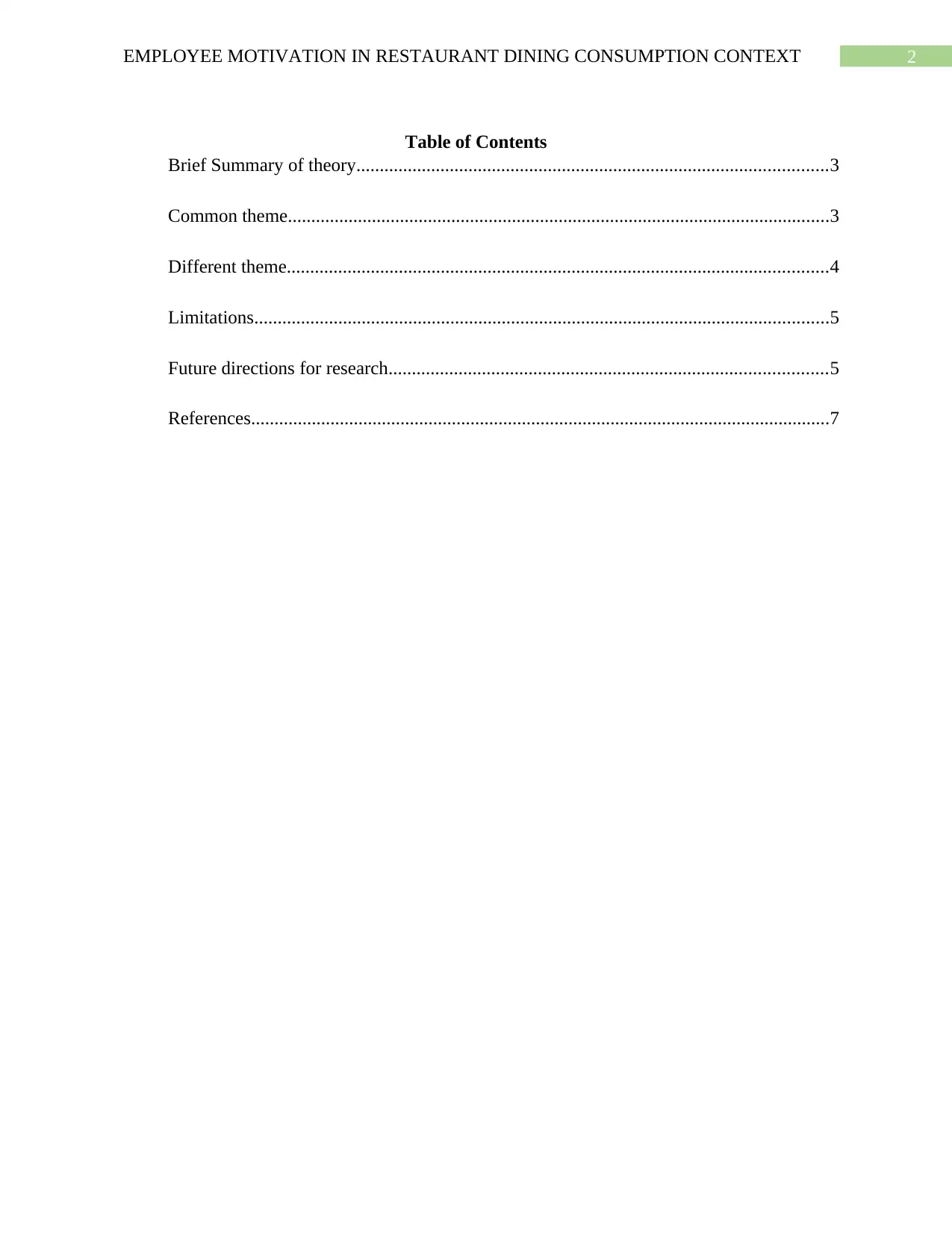
2EMPLOYEE MOTIVATION IN RESTAURANT DINING CONSUMPTION CONTEXT
Table of Contents
Brief Summary of theory.....................................................................................................3
Common theme....................................................................................................................3
Different theme....................................................................................................................4
Limitations...........................................................................................................................5
Future directions for research..............................................................................................5
References............................................................................................................................7
Table of Contents
Brief Summary of theory.....................................................................................................3
Common theme....................................................................................................................3
Different theme....................................................................................................................4
Limitations...........................................................................................................................5
Future directions for research..............................................................................................5
References............................................................................................................................7
⊘ This is a preview!⊘
Do you want full access?
Subscribe today to unlock all pages.

Trusted by 1+ million students worldwide
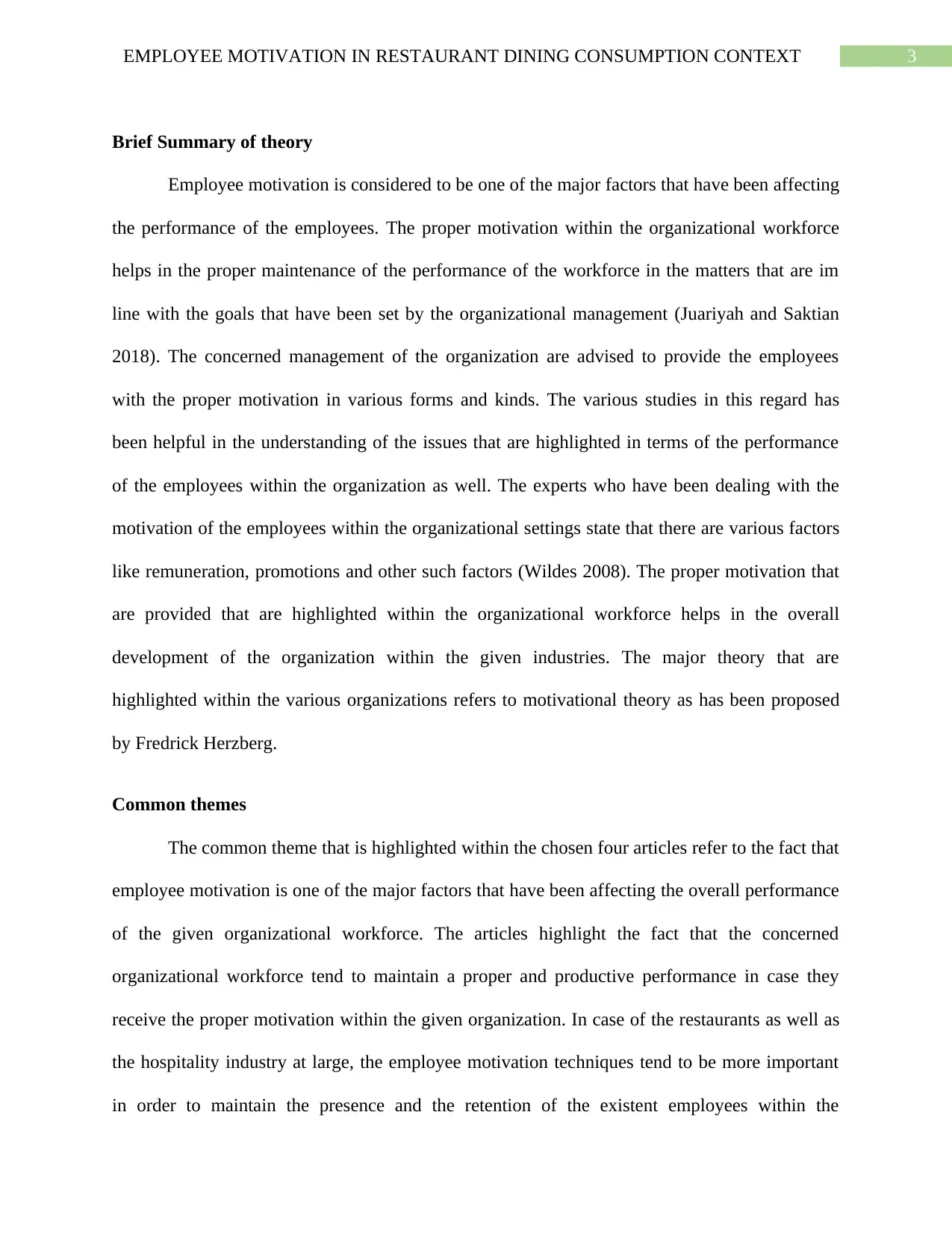
3EMPLOYEE MOTIVATION IN RESTAURANT DINING CONSUMPTION CONTEXT
Brief Summary of theory
Employee motivation is considered to be one of the major factors that have been affecting
the performance of the employees. The proper motivation within the organizational workforce
helps in the proper maintenance of the performance of the workforce in the matters that are im
line with the goals that have been set by the organizational management (Juariyah and Saktian
2018). The concerned management of the organization are advised to provide the employees
with the proper motivation in various forms and kinds. The various studies in this regard has
been helpful in the understanding of the issues that are highlighted in terms of the performance
of the employees within the organization as well. The experts who have been dealing with the
motivation of the employees within the organizational settings state that there are various factors
like remuneration, promotions and other such factors (Wildes 2008). The proper motivation that
are provided that are highlighted within the organizational workforce helps in the overall
development of the organization within the given industries. The major theory that are
highlighted within the various organizations refers to motivational theory as has been proposed
by Fredrick Herzberg.
Common themes
The common theme that is highlighted within the chosen four articles refer to the fact that
employee motivation is one of the major factors that have been affecting the overall performance
of the given organizational workforce. The articles highlight the fact that the concerned
organizational workforce tend to maintain a proper and productive performance in case they
receive the proper motivation within the given organization. In case of the restaurants as well as
the hospitality industry at large, the employee motivation techniques tend to be more important
in order to maintain the presence and the retention of the existent employees within the
Brief Summary of theory
Employee motivation is considered to be one of the major factors that have been affecting
the performance of the employees. The proper motivation within the organizational workforce
helps in the proper maintenance of the performance of the workforce in the matters that are im
line with the goals that have been set by the organizational management (Juariyah and Saktian
2018). The concerned management of the organization are advised to provide the employees
with the proper motivation in various forms and kinds. The various studies in this regard has
been helpful in the understanding of the issues that are highlighted in terms of the performance
of the employees within the organization as well. The experts who have been dealing with the
motivation of the employees within the organizational settings state that there are various factors
like remuneration, promotions and other such factors (Wildes 2008). The proper motivation that
are provided that are highlighted within the organizational workforce helps in the overall
development of the organization within the given industries. The major theory that are
highlighted within the various organizations refers to motivational theory as has been proposed
by Fredrick Herzberg.
Common themes
The common theme that is highlighted within the chosen four articles refer to the fact that
employee motivation is one of the major factors that have been affecting the overall performance
of the given organizational workforce. The articles highlight the fact that the concerned
organizational workforce tend to maintain a proper and productive performance in case they
receive the proper motivation within the given organization. In case of the restaurants as well as
the hospitality industry at large, the employee motivation techniques tend to be more important
in order to maintain the presence and the retention of the existent employees within the
Paraphrase This Document
Need a fresh take? Get an instant paraphrase of this document with our AI Paraphraser
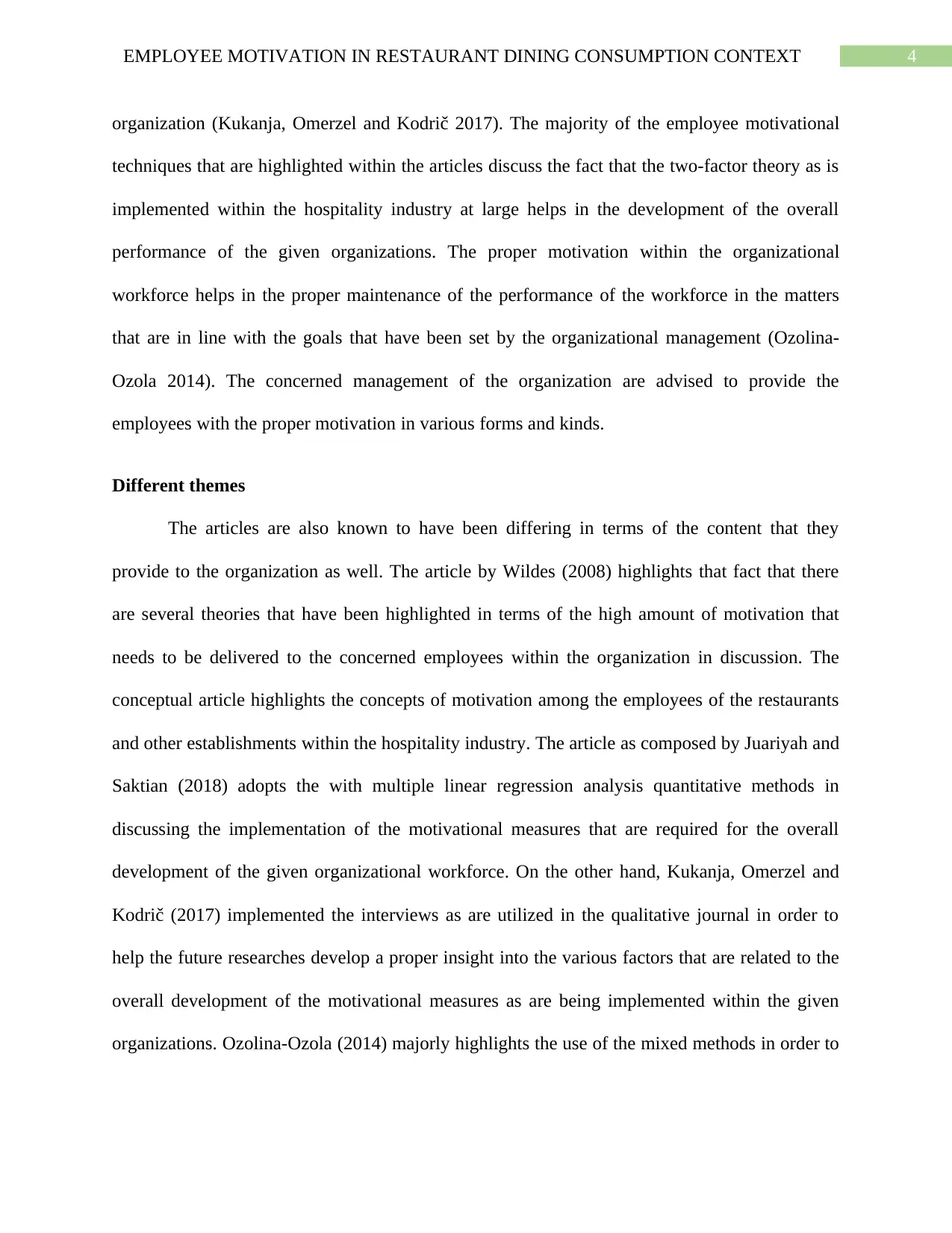
4EMPLOYEE MOTIVATION IN RESTAURANT DINING CONSUMPTION CONTEXT
organization (Kukanja, Omerzel and Kodrič 2017). The majority of the employee motivational
techniques that are highlighted within the articles discuss the fact that the two-factor theory as is
implemented within the hospitality industry at large helps in the development of the overall
performance of the given organizations. The proper motivation within the organizational
workforce helps in the proper maintenance of the performance of the workforce in the matters
that are in line with the goals that have been set by the organizational management (Ozolina-
Ozola 2014). The concerned management of the organization are advised to provide the
employees with the proper motivation in various forms and kinds.
Different themes
The articles are also known to have been differing in terms of the content that they
provide to the organization as well. The article by Wildes (2008) highlights that fact that there
are several theories that have been highlighted in terms of the high amount of motivation that
needs to be delivered to the concerned employees within the organization in discussion. The
conceptual article highlights the concepts of motivation among the employees of the restaurants
and other establishments within the hospitality industry. The article as composed by Juariyah and
Saktian (2018) adopts the with multiple linear regression analysis quantitative methods in
discussing the implementation of the motivational measures that are required for the overall
development of the given organizational workforce. On the other hand, Kukanja, Omerzel and
Kodrič (2017) implemented the interviews as are utilized in the qualitative journal in order to
help the future researches develop a proper insight into the various factors that are related to the
overall development of the motivational measures as are being implemented within the given
organizations. Ozolina-Ozola (2014) majorly highlights the use of the mixed methods in order to
organization (Kukanja, Omerzel and Kodrič 2017). The majority of the employee motivational
techniques that are highlighted within the articles discuss the fact that the two-factor theory as is
implemented within the hospitality industry at large helps in the development of the overall
performance of the given organizations. The proper motivation within the organizational
workforce helps in the proper maintenance of the performance of the workforce in the matters
that are in line with the goals that have been set by the organizational management (Ozolina-
Ozola 2014). The concerned management of the organization are advised to provide the
employees with the proper motivation in various forms and kinds.
Different themes
The articles are also known to have been differing in terms of the content that they
provide to the organization as well. The article by Wildes (2008) highlights that fact that there
are several theories that have been highlighted in terms of the high amount of motivation that
needs to be delivered to the concerned employees within the organization in discussion. The
conceptual article highlights the concepts of motivation among the employees of the restaurants
and other establishments within the hospitality industry. The article as composed by Juariyah and
Saktian (2018) adopts the with multiple linear regression analysis quantitative methods in
discussing the implementation of the motivational measures that are required for the overall
development of the given organizational workforce. On the other hand, Kukanja, Omerzel and
Kodrič (2017) implemented the interviews as are utilized in the qualitative journal in order to
help the future researches develop a proper insight into the various factors that are related to the
overall development of the motivational measures as are being implemented within the given
organizations. Ozolina-Ozola (2014) majorly highlights the use of the mixed methods in order to
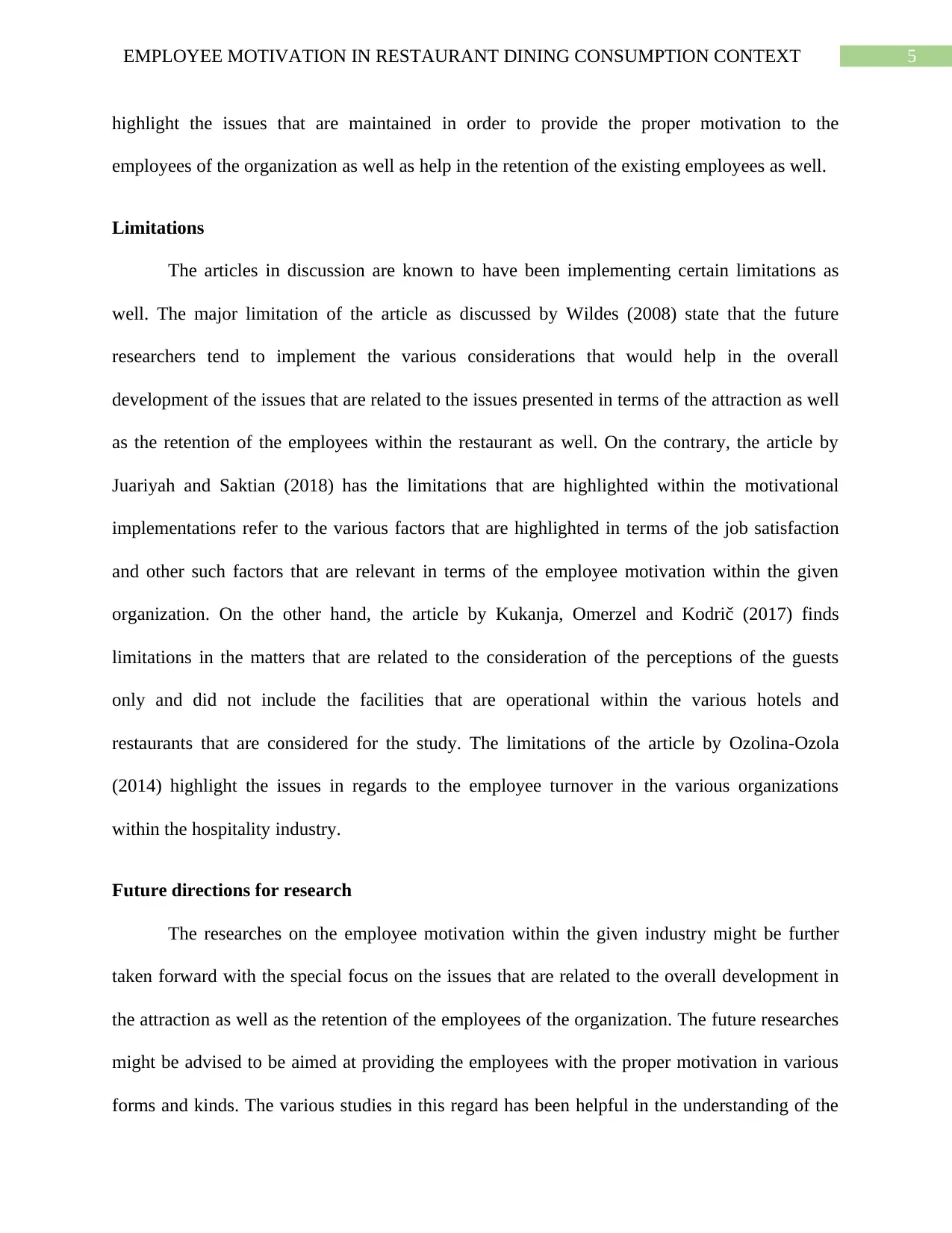
5EMPLOYEE MOTIVATION IN RESTAURANT DINING CONSUMPTION CONTEXT
highlight the issues that are maintained in order to provide the proper motivation to the
employees of the organization as well as help in the retention of the existing employees as well.
Limitations
The articles in discussion are known to have been implementing certain limitations as
well. The major limitation of the article as discussed by Wildes (2008) state that the future
researchers tend to implement the various considerations that would help in the overall
development of the issues that are related to the issues presented in terms of the attraction as well
as the retention of the employees within the restaurant as well. On the contrary, the article by
Juariyah and Saktian (2018) has the limitations that are highlighted within the motivational
implementations refer to the various factors that are highlighted in terms of the job satisfaction
and other such factors that are relevant in terms of the employee motivation within the given
organization. On the other hand, the article by Kukanja, Omerzel and Kodrič (2017) finds
limitations in the matters that are related to the consideration of the perceptions of the guests
only and did not include the facilities that are operational within the various hotels and
restaurants that are considered for the study. The limitations of the article by Ozolina-Ozola
(2014) highlight the issues in regards to the employee turnover in the various organizations
within the hospitality industry.
Future directions for research
The researches on the employee motivation within the given industry might be further
taken forward with the special focus on the issues that are related to the overall development in
the attraction as well as the retention of the employees of the organization. The future researches
might be advised to be aimed at providing the employees with the proper motivation in various
forms and kinds. The various studies in this regard has been helpful in the understanding of the
highlight the issues that are maintained in order to provide the proper motivation to the
employees of the organization as well as help in the retention of the existing employees as well.
Limitations
The articles in discussion are known to have been implementing certain limitations as
well. The major limitation of the article as discussed by Wildes (2008) state that the future
researchers tend to implement the various considerations that would help in the overall
development of the issues that are related to the issues presented in terms of the attraction as well
as the retention of the employees within the restaurant as well. On the contrary, the article by
Juariyah and Saktian (2018) has the limitations that are highlighted within the motivational
implementations refer to the various factors that are highlighted in terms of the job satisfaction
and other such factors that are relevant in terms of the employee motivation within the given
organization. On the other hand, the article by Kukanja, Omerzel and Kodrič (2017) finds
limitations in the matters that are related to the consideration of the perceptions of the guests
only and did not include the facilities that are operational within the various hotels and
restaurants that are considered for the study. The limitations of the article by Ozolina-Ozola
(2014) highlight the issues in regards to the employee turnover in the various organizations
within the hospitality industry.
Future directions for research
The researches on the employee motivation within the given industry might be further
taken forward with the special focus on the issues that are related to the overall development in
the attraction as well as the retention of the employees of the organization. The future researches
might be advised to be aimed at providing the employees with the proper motivation in various
forms and kinds. The various studies in this regard has been helpful in the understanding of the
⊘ This is a preview!⊘
Do you want full access?
Subscribe today to unlock all pages.

Trusted by 1+ million students worldwide
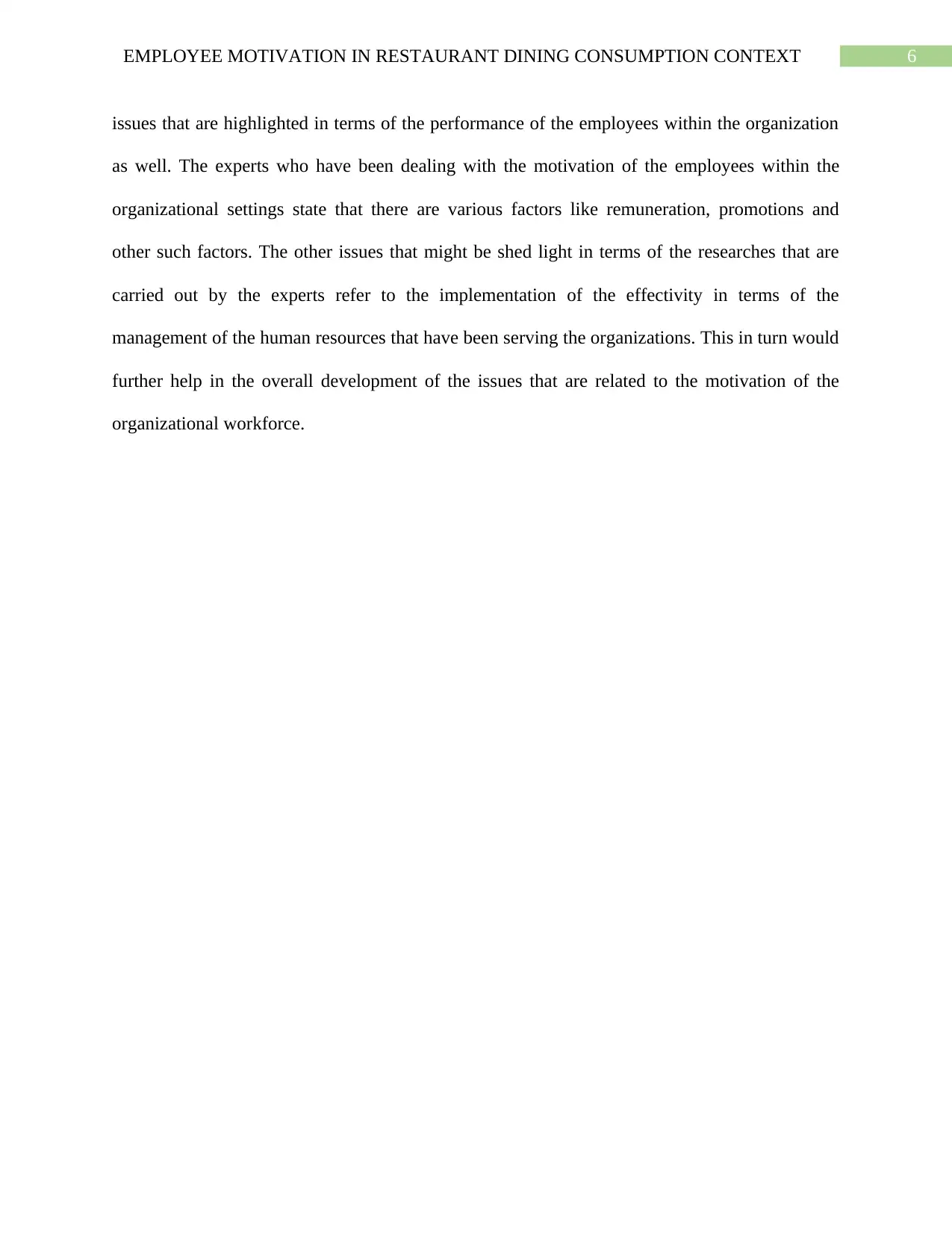
6EMPLOYEE MOTIVATION IN RESTAURANT DINING CONSUMPTION CONTEXT
issues that are highlighted in terms of the performance of the employees within the organization
as well. The experts who have been dealing with the motivation of the employees within the
organizational settings state that there are various factors like remuneration, promotions and
other such factors. The other issues that might be shed light in terms of the researches that are
carried out by the experts refer to the implementation of the effectivity in terms of the
management of the human resources that have been serving the organizations. This in turn would
further help in the overall development of the issues that are related to the motivation of the
organizational workforce.
issues that are highlighted in terms of the performance of the employees within the organization
as well. The experts who have been dealing with the motivation of the employees within the
organizational settings state that there are various factors like remuneration, promotions and
other such factors. The other issues that might be shed light in terms of the researches that are
carried out by the experts refer to the implementation of the effectivity in terms of the
management of the human resources that have been serving the organizations. This in turn would
further help in the overall development of the issues that are related to the motivation of the
organizational workforce.
Paraphrase This Document
Need a fresh take? Get an instant paraphrase of this document with our AI Paraphraser
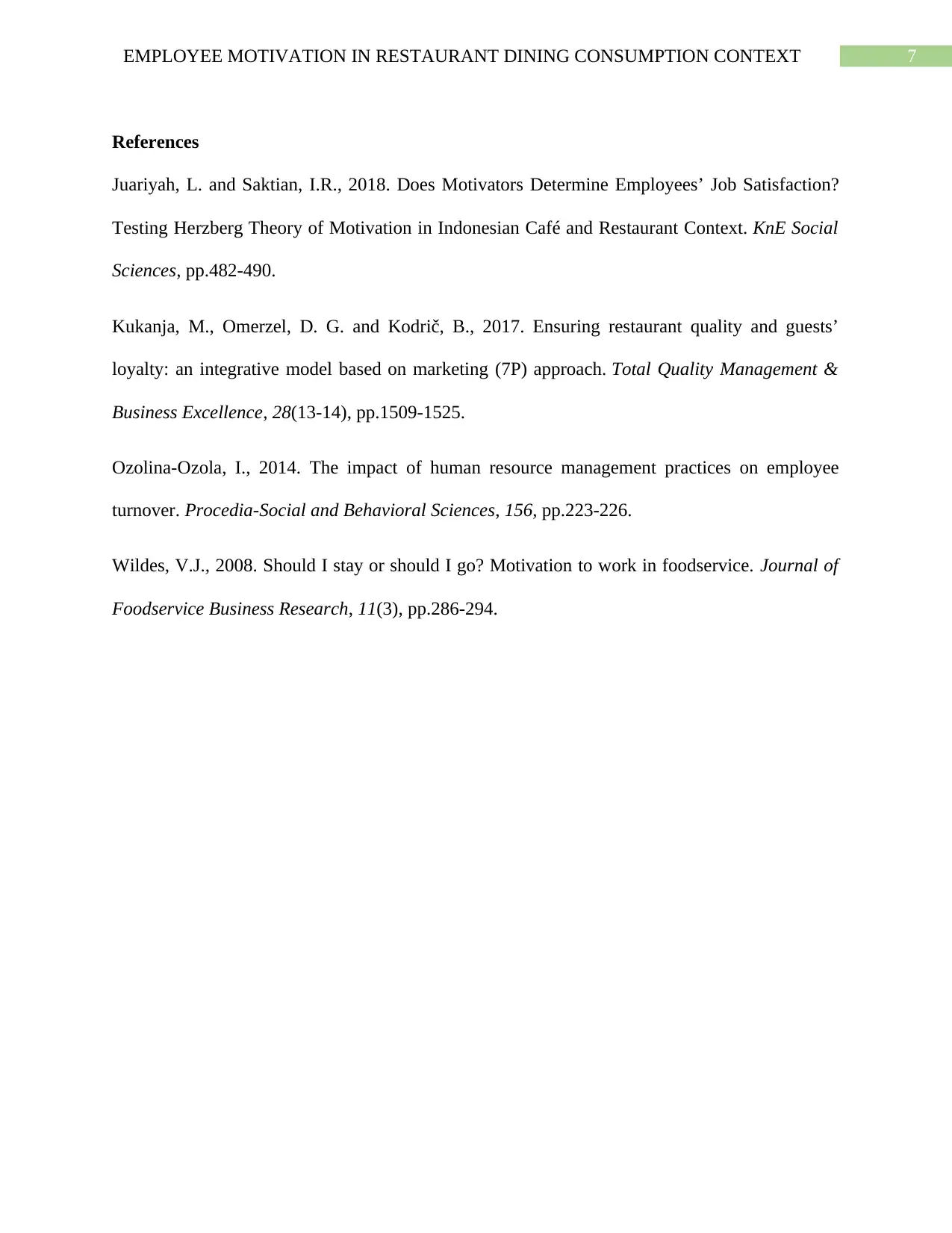
7EMPLOYEE MOTIVATION IN RESTAURANT DINING CONSUMPTION CONTEXT
References
Juariyah, L. and Saktian, I.R., 2018. Does Motivators Determine Employees’ Job Satisfaction?
Testing Herzberg Theory of Motivation in Indonesian Café and Restaurant Context. KnE Social
Sciences, pp.482-490.
Kukanja, M., Omerzel, D. G. and Kodrič, B., 2017. Ensuring restaurant quality and guests’
loyalty: an integrative model based on marketing (7P) approach. Total Quality Management &
Business Excellence, 28(13-14), pp.1509-1525.
Ozolina-Ozola, I., 2014. The impact of human resource management practices on employee
turnover. Procedia-Social and Behavioral Sciences, 156, pp.223-226.
Wildes, V.J., 2008. Should I stay or should I go? Motivation to work in foodservice. Journal of
Foodservice Business Research, 11(3), pp.286-294.
References
Juariyah, L. and Saktian, I.R., 2018. Does Motivators Determine Employees’ Job Satisfaction?
Testing Herzberg Theory of Motivation in Indonesian Café and Restaurant Context. KnE Social
Sciences, pp.482-490.
Kukanja, M., Omerzel, D. G. and Kodrič, B., 2017. Ensuring restaurant quality and guests’
loyalty: an integrative model based on marketing (7P) approach. Total Quality Management &
Business Excellence, 28(13-14), pp.1509-1525.
Ozolina-Ozola, I., 2014. The impact of human resource management practices on employee
turnover. Procedia-Social and Behavioral Sciences, 156, pp.223-226.
Wildes, V.J., 2008. Should I stay or should I go? Motivation to work in foodservice. Journal of
Foodservice Business Research, 11(3), pp.286-294.
1 out of 8
Related Documents
Your All-in-One AI-Powered Toolkit for Academic Success.
+13062052269
info@desklib.com
Available 24*7 on WhatsApp / Email
![[object Object]](/_next/static/media/star-bottom.7253800d.svg)
Unlock your academic potential
Copyright © 2020–2025 A2Z Services. All Rights Reserved. Developed and managed by ZUCOL.




